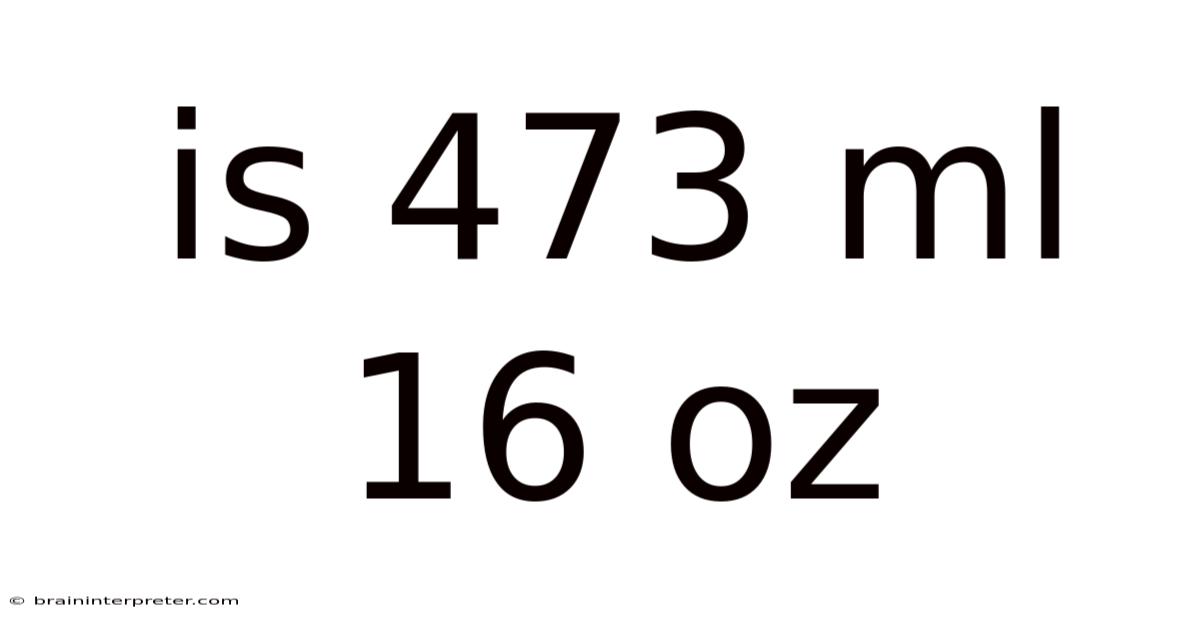Is 473 Ml 16 Oz
braininterpreter
Sep 16, 2025 · 5 min read

Table of Contents
Is 473 ml 16 oz? A Deep Dive into Metric and Imperial Conversions
Are you ever confused by the seemingly simple conversion between milliliters (ml) and ounces (oz)? Many recipes, product labels, and everyday measurements use both metric and imperial units, leading to understandable confusion. This article will clarify the relationship between milliliters and ounces, specifically addressing the common question: Is 473 ml equal to 16 oz? We’ll explore the conversion process, delve into potential sources of discrepancy, and provide a comprehensive understanding of volume measurement across different systems.
Understanding Units of Volume: ml and oz
Before diving into the specifics of the 473 ml to 16 oz conversion, let's establish a foundation by understanding the units involved.
-
Milliliters (ml): This is a unit of volume in the metric system. The metric system is based on powers of 10, making conversions relatively straightforward. One milliliter is equal to one cubic centimeter (cm³).
-
Fluid Ounces (fl oz): This is a unit of volume in the imperial system, which is used primarily in the United States and a few other countries. The imperial system is less standardized than the metric system, and conversions can be more complex. The fluid ounce is often shortened to "oz" and is distinct from the avoirdupois ounce (oz), a unit of mass. We'll focus on fluid ounces in this context as we're dealing with volume.
The key difference lies in the systems' bases. The metric system is decimal-based (base 10), while the imperial system uses various non-decimal bases. This difference impacts the complexity of conversions.
The Conversion: 473 ml to 16 oz
The commonly cited conversion is that 1 US fluid ounce is approximately equal to 29.57 milliliters. Therefore, a simple calculation suggests that:
16 fl oz * 29.57 ml/fl oz ≈ 473.12 ml
This calculation indicates that 473 ml is indeed very close to 16 fluid ounces. The slight discrepancy is due to rounding in the conversion factor.
Therefore, while not perfectly identical, 473 ml is practically equivalent to 16 fluid ounces for most practical purposes. The difference is negligible in many situations, especially in cooking or casual measurements.
Sources of Discrepancy and Variations
While the approximation of 473 ml ≈ 16 fl oz holds true in most cases, there are factors that can lead to minor variations:
-
Rounding Errors: As mentioned, the conversion factor (29.57 ml/fl oz) is itself an approximation. Rounding during calculations can accumulate small errors.
-
Measurement Accuracy: The accuracy of the measuring instruments used significantly impacts the results. Different measuring cups, jugs, or scales may have varying degrees of precision. Slight variations in measurements can lead to differences in the final volume.
-
Temperature: The volume of liquids can change slightly with temperature fluctuations. This effect might be minimal in most situations but could become noticeable in precise scientific measurements.
-
Imperial vs. US Customary: There's a subtle difference between the imperial fluid ounce and the US customary fluid ounce. While often used interchangeably, they have slightly different definitions leading to very small discrepancies in conversions.
Practical Applications and Examples
The equivalence of 473 ml and 16 oz is widely used in various applications:
-
Food and Beverage Industry: Many bottled drinks, such as soda or juice, are labeled with both metric (ml) and imperial (oz) units. A 16-ounce bottle is often equivalent to a 473-ml bottle.
-
Cooking and Baking: Recipes frequently provide measurements in both systems to cater to different audiences. Converting between milliliters and ounces is essential for accurate measurements in cooking and baking.
-
Medical Applications: Certain medications or solutions may be measured in either milliliters or ounces, depending on the region and context. Conversion is important for proper dosage.
Frequently Asked Questions (FAQ)
Q: Can I use 473 ml instead of 16 oz in a recipe?
A: Yes, for most recipes, 473 ml is a perfectly acceptable substitute for 16 oz. The difference is generally negligible and won't significantly impact the outcome.
Q: Is the conversion factor always 29.57 ml/fl oz?
A: The conversion factor is approximately 29.57 ml/fl oz, but slight variations may exist depending on the level of precision required and the specific definition of the fluid ounce (US customary vs. imperial).
Q: Why are there two different systems of measurement?
A: The metric system was designed to be a simpler and more consistent system based on powers of ten, while the imperial system evolved over time with various historical influences, leading to its less unified nature.
Q: Which system is better to use?
A: The metric system is generally considered more practical and easier to use for scientific and everyday purposes due to its decimal-based nature. However, the imperial system remains prevalent in certain countries and contexts.
Conclusion: A Practical Equivalence
While a precise mathematical equivalence doesn't exist, 473 ml is practically interchangeable with 16 fluid ounces for most everyday uses. The small difference arising from rounding or measurement variations is usually insignificant in cooking, casual measurements, and many other applications. Understanding the underlying principles of metric and imperial units, along with the approximate conversion factor, allows for accurate conversions and eliminates potential confusion arising from the use of both systems. The key takeaway is that the slight discrepancy is often negligible, making 473 ml a reliable approximation for 16 oz in the vast majority of situations. Remember to always consider the context and required level of accuracy when making conversions.
Latest Posts
Latest Posts
-
What Is 30cm In Feet
Sep 17, 2025
-
1 3 Cup In Ounces
Sep 17, 2025
-
30 Days From March 31
Sep 17, 2025
Related Post
Thank you for visiting our website which covers about Is 473 Ml 16 Oz . We hope the information provided has been useful to you. Feel free to contact us if you have any questions or need further assistance. See you next time and don't miss to bookmark.